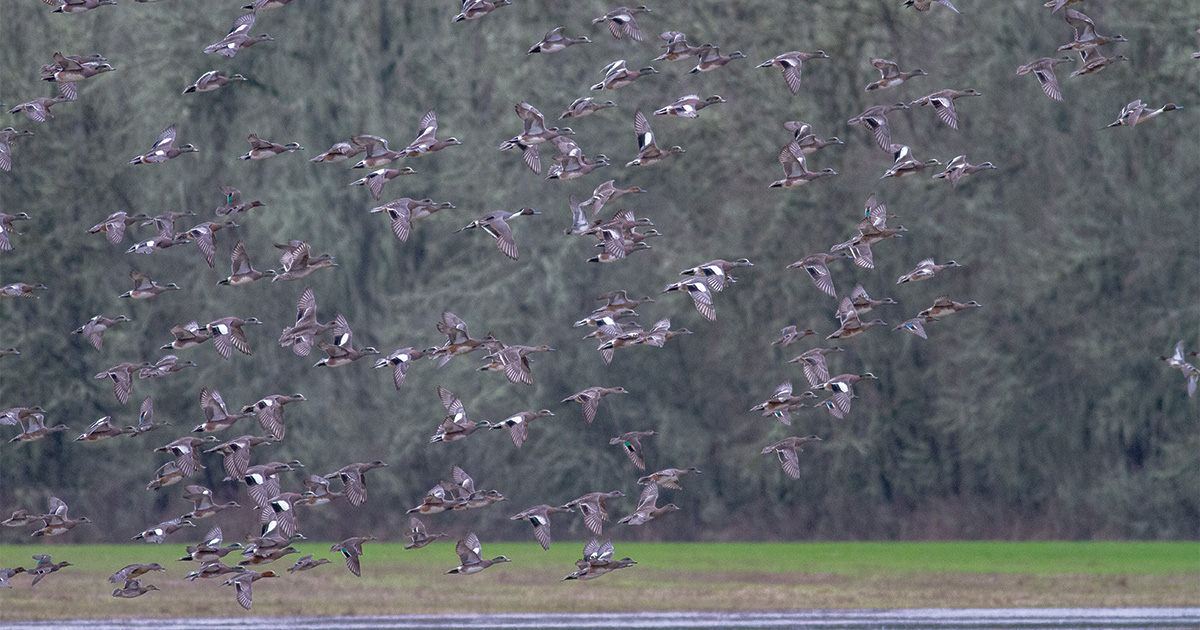Migration Alert: Optimism for Duck Season Soars in California Due to Good Habitat, Waterfowl Numbers
Oct. 15, 2025 – Pacific Flyway – California
Oct. 15, 2025 – Pacific Flyway – California

There are so many early arriving white-fronted geese in the Central Valley, it has scientists and waterfowl hunters perplexed. It isn’t unusual to observe whitefronts in small flocks from the Oregon border to the San Joaquin Valley’s Mendota Wildlife Area in late September and early October. What is not normal, however, are the massive flocks that are working dry fields, newly flooded wetlands, and flooded rice fields. The numbers are staggering.
What triggered the early migration from the Yukon-Kuskokwim Delta of Alaska is anyone’s guess, but these coveted geese are migrating en masse. Their presence has elevated expectations for a sensational California duck and goose hunting season, which opens October 18 in most parts of the state. Approximately one-third of all wintering waterfowl in California originate in Alaska.
Another positive is the dramatic increase in local production, especially mallards, which are up 50 percent from last year. The big jump to 265,640 breeding birds is the highest since 2018 and is due primarily to the improved habitat conditions at Tule Lake and Lower Klamath National Wildlife Refuges (NWR), where adequate water has returned following a winter with unprecedented snowfall in northeastern California. Hunters also are enthusiastic about the new three-bird daily limit for northern pintails.
Following the Northeastern Zone opener on October 4, field scout Yancey Forrest Knowles says, “There were a lot of birds around, like in the good old days.” He describes big flocks of mallards, gadwall, northern pintails, and green-winged teal holding on Lower Klamath’s Miller Lake and the closed-zone sump at Tule Lake. The numbers of Canada geese also seem strong. Hunters will enjoy about 1,000 acres of walk-in wetlands at Tule Lake, a new opportunity this year.
Adequate water and good habitat attracted heavy concentrations of waterfowl at Modoc NWR and at Butte Valley, Shasta Valley, Ash Creek, and Honey Lake Wildlife Areas.
The overarching hope is that the increased number of birds that were hatched in northeastern California this year will combine with migrating birds from Alaska and Canada to fill the skies and the wintering habitat farther south in the Central Valley.
That optimism is already playing out. In northern reaches of California, flooded rice fields from east of Marysville, west to Gridley, and south to below Yuba City are covered with white-fronted geese. Northern pintails, green-winged teal, wigeon, and shovelers are the most prominent ducks at Dingville, while white-fronted geese loaf in flocks of hundreds.
Normal flood-up, along with adequate and well-timed water, is greeting birds at Sutter, Sacramento, Colusa, and Delevan NWRs, as well as at the crown jewel of the state wildlife areas, Gray Lodge, where adequate water allowed for 1,600 acres of spring irrigation.
West of Sacramento and the Sacramento River–San Joaquin River Delta between Stockton and Rio Vista, the local hatch of mallards, cinnamon teal, and wood ducks was strong. Few northern birds are showing yet, with the exception of northern pintails and sandhill cranes. White-fronted geese are already thick at Ryer Island and the Nature Conservancy’s Staton Island, as well as on private fields along Interstate 5 between Sacramento and Stockton.
The fabled Suisun Marsh produced big numbers of gadwall and mallards this summer. At Grizzly Island Wildlife Area, about 850 acres of summer water was maintained to boost production.
“Seeing so many whitefronts this early in the year is wonderful,” says John Trede, who hunts both the Delta and Grasslands. “It is so unusual and makes me wonder if ducks will be migrating early as well.”
In the northern San Joaquin Valley, pintails showed up the last week of July at Volta Wildlife Area and at private waters in the south Grasslands Ecological Area between Los Banos and Dos Palos. The duck buildup throughout the Grasslands has been impressive. In addition to pintails, there are green-winged teal and shovelers using open water. Local mallards, which had decent production, can be found mostly in the riparian zones.
Farther south, the outlook is good at Mendota Wildlife Area, but water is scarce, and not all wetlands will be flooded. As usual, Kern NWR will not open until October 18. The San Jacinto Valley—including duck clubs and the San Jacinto Wildlife Area—are fully flooded, but there are not many ducks.
“We’re just not seeing birds,” reports Joe Fass at the Ramona Duck Club. “It is warm, 95 degrees on October 10, not exactly what you’d call duck weather. We’ve grown a ton of swamp timothy, so the table is set when the birds do arrive.”
Stay up to date with the latest migration information.
Ducks Unlimited uses cookies to enhance your browsing experience, optimize site functionality, analyze traffic, and deliver personalized advertising through third parties. By continuing to use this site, you agree to our use of cookies. View Privacy Policy